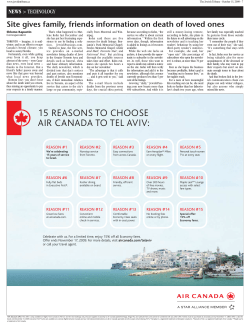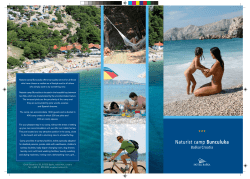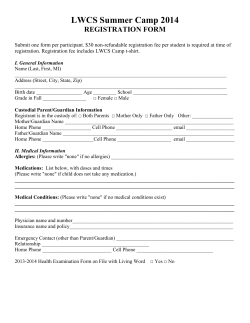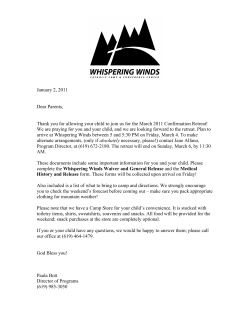
Children and Youth as Georges-André Kohn Victims of the Nazi Crimes from Paris
Children and Youth as Victims of the Nazi Crimes Georges-André Kohn from Paris 1932–1945 Seventy years ago, the National Socialists came to power in Germany. During their rule, which lasted until 1945, they persecuted and terrorized human beings because of their origin, religion or physical or mental handicap. The National Socialists attacked many countries in Europe, occupied them and murdered many millions, including six million Jews from across Europe. On this web site, we wish to remember five young people who became victims of Nazi terror. www.stiftung-denkmal.de Georges-André Kohn Georges-André Kohn was born in Paris on April 23, 1932. He had three brothers and sisters. His father Armand Kohn was a physician and director of the hospital »Baron de Rothschild«, the largest Jewish hospital in Paris. The Kohn family was of the Roman Catholic faith. But in 1940, when the Germans invaded and occupied France, Nazi thinking suddenly declared them to be Jews because they had Jewish ancestry. They were thus rendered defenseless victims exposed to persecution by the Nazi occupiers. Georges at the age of two in the arms of his mother, 1934. Source: Neuengamme concentration camp memorial Georges André Kohn Page 1a www.stiftung-denkmal.de Georges-André Kohn Georges was twelve years old when, together with his parents, brothers and sisters and grandmother, he was arrested on July 28, 1944 and taken to the collection camp Drancy 1. On August 17, 1944, a few days before the liberation of Paris by the Allies, the entire family was deported on the last transport from Drancy to the East. Georges’ brother Philippe and his sister Rose-Marie managed to escape from the train shortly after it had left Paris. A railroad official took them into hiding until the final liberation of France on September 2, 1944. Both survived the war. The rest of the family awaited a horrible fate. Georges-André Kohn with his brothers and sisters, from left to right: Georges-André, Rose-Marie, Philippe and Antoinette; exact location unknown, about 1939. Source: Neuengamme concentration camp memorial Georges André Kohn Page 1b www.stiftung-denkmal.de Georges-André Kohn On August 25, 1944, the transport stopped at the Buchenwald 2 concentration camp. There the family was torn apart. The Nazis 3 placed Georges’ father in Buchenwald. He survived the camp, but for a long time was unable to learn anything about the fate of his son Georges. Georges’ mother and sister Antoinette were transported from Buchenwald to the concentration camp Bergen-Belsen 4. The two died there a short time later. Georges and his grandmother were shipped to Auschwitz-Birkenau 5. His grandmother was murdered in the gas chamber immediately after their arrival. Georges at his first communion 1942, two years before his deportation to AuschwitzBirkenau Source: Neuengamme concentration camp memorial Georges André Kohn Page 2a www.stiftung-denkmal.de Georges-André Kohn Georges was placed in Barrack No. 11, which housed 19 other Jewish children from all over Europe, aged between five and twelve years. The Nazis wished to use these children for medical experiments 6. Among the children was Jacqueline Morgenstern, who was the same age as Georges and also came from Paris. The two quickly became friends because they were the only French children in the group. A photo of Jacqueline Morgenstern has survived. Jacqueline Morgenstern at the age of seven, 1940, exact location where the photo was taken is unknown Source: Neuengamme concentration camp memorial Georges André Kohn Page 2b www.stiftung-denkmal.de Georges-André Kohn Initially the children appeared to be better off than the other inmates in AuschwitzBirkenau 5. Their barracks building was heated and they were given enough to eat. But in actual fact they were forced to do strenuous physical labor and were abused in medical experimentation. Toward the end of the war, as the Red Army advanced, Georges together with the 19 other children was transported in late November 1944 to the Neuengamme 7 concentration camp near Hamburg. There the SS doctor Kurt Heißmeier performed cruel and horrible medical experiments on them. He infected the children with tuberculosis 8, a lethal lung disease. Shortly before Christmas 1944 all the children were seriously ill. Georges was especially weak and was unable to stand up by himself, as the French inmate doctors and Dutch nurses later reported. These nurses and doctors were themselves prisoners. They took care of and administered to the children, becoming their surrogate parents. The SS 9 doctor Kurt Heißmeier removed the lymph nodes of the children because he believed they contained specific substances generated by the body to protect against TB. However, it was already common medical knowledge at the time that this was not the case. His cruel experiments were sheer agony and totally meaningless scientifically. After he had removed all the lymph nodes from the children, he had them photographed. The children had to lift up their arms to display their operation scars to the camera. In the photograph, Georges’ scar in the upper left part of the body is barely visible. Georges-André Kohn, photographed after the operation in 1945 in the Neuengamme concentration camp Source: Neuengamme concentration camp memorial Georges André Kohn Page 3 www.stiftung-denkmal.de Georges-André Kohn In April 1945, the end of the war was rapidly approaching. The days of the Nazi regime were numbered. The SS doctors and the camp leadership in Neuengamme feared that they could be punished by the Allies if their atrocities became known. In order to cover up their crimes performed on the children, a few days before the war’s end the SS leadership set the children together with their nurses to the school on Bullenhuser Damm, located in a bombed-out and abandoned section of the city of Hamburg. There, on April 20, 1945, the SS hung all the children in the school’s basement. The SS officer in charge of the murder squad, Arnold Strippel, was acquitted of all wrongdoing, after his trial had been postponed for many years in the Federal Republic of Germany. Undetected, the SS doctor Kurt Heißmeier practiced as a specialist for lung diseases in Magdeburg down to 1964. In 1966 he was sentenced to life imprisonment by a court in the German Democratic Republic. School on Bullenhuser Damm where the 20 children were hanged. Photograph around 1960. Source: Neuengamme concentration camp memorial Georges André Kohn Page 4a www.stiftung-denkmal.de Georges-André Kohn The names of the children of Bullenhuser Damm: 35 years later, a memorial was established in the school on Bullenhuser Mania Altmann, 5 years old, from Poland Lelka Birnbaum, 12 years old, from Poland Surcis Goldinger, 11 years old, from Poland Riwka Herszberg, 7 years old, from Poland Alexander Hornemann, 8 years old, from the Netherlands Eduard Hornemann, 12 years old, from the Netherlands Marek James, 6 years old, from Poland W. Junglieb, 12 years old, from Yugoslavia Lea Klygermann, 8 years old, from Poland Georges-André Kohn, 12 years old, from France Blumel Mekler, 11 years old, from Poland Jacqueline Morgenstern, 12 years old, from France Sergio de Simone, 7 years old, from Italy Marek Steinbaum, 10 years old, from Poland H. Wassermann, 8 years old, from Poland Eleonora Witonska, 5 years old, from Poland Roman Zeller, 12 years old, from Poland Ruchla Zylberberg, 9 years old, from Poland Damm in remembrance of the murdered children. The Association »Children of Bullenhuser Damm« planted a rose garden behind the school building. In addition, twenty streets in the northern area of Hamburg were named in 1991 after the children, including one named after Georges-André Kohn. Das Straßenschild, das an Georges-André Kohns Schicksal erinnern soll. Source: Neuengamme concentration camp memorial Georges André Kohn Page 4b www.stiftung-denkmal.de Medical Experiments In many concentration camps10, German doctors abused prisoners in medical experimentation. In this they exceeded all standards of medical practice and ethics. The death of the human »guinea pig« was anticipated as a necessary outcome of these tests. The first commandment of doctors to do everything in their power to improve the condition of the patient was totally ignored. In the world view of the Nazis, the Jews and many others were considered »inferior« human beings. This provided the doctors with a justification for performing cruel experiments without anesthesia, antiseptic disinfection and similar procedures. In most cases these doctors proceeded with their experiments on the basis of absurd hypotheses. Their findings were in the main totally useless and irrelevant for science. But they were performed on the pretext that they were in the service of »public health.« The victims of this medical experimentation were mainly Jews, Sinti and Roma and Soviet POWs. More than 350 doctors were implicated in these experiments. After the war, only a small number of them were tried and convicted before the Nuremberg Military Tribunal11 or in courts in the Federal Republic of Germany. Georges André Kohn Background Text www.stiftung-denkmal.de Glossary 1 1 Drancy (Collection and Transit Camp) Established in 1941 in a complex of concrete buildings belonging to an unfinished public housing project northeast of Paris; under the supervision of the Dept. for Jewish Affairs of the Gestapo (Secret State Police) in occupied France. From June 22, 1942 until August 17, 1944, some 67,000 French Jews and Jews who had fled to France were deported largely from Drancy to Auschwitz-Birkenau. Only about 2,000 survived. 2 Buchenwald Concentration Camp Built in 1937 on the Ettersberg near Weimar (Thuringia). Its inmates were political opponents, Jehovah’s Witnesses, Sinti and Roma, and criminal prisoners (so-called »asocial persons«). In 1938 in the aftermath of the November pogrom, thousands of Jews were interned here. Of the more than 250,000 prisoners in Buchenwald and its 130 subcamps, more than 50,000 lost their lives. Liberated in April 1945 by the U.S. Army. 3 National Socialism A political movement, founded in 1920 as the Nationalsozialistische Deutsche Arbeiterpartei (NSDAP, the National Socialist German Workers’ Party). From 1921 on led by Adolf Hitler. In 1933, it took over the reins of state power in the German Reich. In 1945, with the end of the war, the party was dissolved. National Socialism propagated an open hatred of the Jews, fought against the democratic state and persecuted those with opposing political convictions, such as Communists. The world view of the National Socialists was characterized by the theory of a superior stronger (so-called Aryan) »race«, to which other weaker and inferior races were subordinate. When the party took over power, this axiom became a guiding criterion for state policy. The concept of »race« is pseudo-scientific. In fact, there are no human races, but only different nationalities, religious and linguistic affiliations. 4 Bergen-Belsen Concentration Camp Built in 1940 near Celle in Lower Saxony. Initially meant to house Belgian and French POWs, from July 1941 on it was used principally to confine Soviet POWs, of whom down to February 1942 some 90 percent, at least 18,000, died of starvation or epidemics. From 1944/1945, it served as a collection and transit camp for inmates from the evacuated concentration camps in the East, resulting in severe overcrowding of the camp. Thousands died of epidemics and exhaustion. Liberation on April 15, 1945 by British troops. 5 Auschwitz Concentration Camp Established in 1940 by the SS west of Cracow (Pol. Kraków) in occupied Poland, consisting of three main camps: the concentration camp Auschwitz, the extermination camp Auschwitz-Birkenau, the labor camp of IG-Farben (BUNA Plant) as well as numerous external subcamps and auxiliary camps. The number of victims who perished here is estimated at 1.5 million, including more than one million Jews. SS doctors performed medical experiments on Jewish and Sinti and Roma children. Georges André Kohn www.stiftung-denkmal.de Glossary 2 6 Medical Experiments Pseudo-scientific experiments on concentration camp inmates; the victims were mainly Jews, Sinti and Roma and POWs. Performed without painkillers or anesthesia. Infection with pathogens, tests of drugs, procedures for sterilization, removal of vital organs, tests of hypothermia and extreme pressure. Some 350 doctors from the SS, university institutes and the Wehrmacht (regular army) participated in these experiments. 7 Neuengamme Concentration Camp Built in 1938 near Hamburg, originally as a subcamp of Sachsenhausen concentration camp. In 1940, it became an independent camp with numerous auxiliary camps. Tens of thousands of prisoners from the occupied countries in Europe were confined in its perimeter, including many resistance fighters. The prisoners had to do forced labor. Almost every second inmate in Neuengamme died. Five days before the end of the war, the SS loaded the approximately 7,000 remaining prisoners on a ship that was mistakenly attacked by the Allies (RAF) and sunk (Cap Arcona Tragedy). 8 Tuberculosis (also known as TB) Caused by the tubercle bacillus. Transmitted by infected droplets sneezed or coughed into the air. 95 percent of all humans have this latent virus, but it breaks out only in about five percent of the carriers. It is prevalent especially among persons with a weakened immune system. Generally the sickness spreads in the lungs and lymph nodes. Frequent symptoms are high fever, lack of energy, nocturnal sweating, loss of appetite, weight loss, and coughing. The illness can prove fatal if not treated in proper time. 9 SS Abbreviation for »Schutzstaffel« (Protective Echelon), established in 1925 as Hitler’s »Bodyguard«. In 1929 it developed into the elite unit of the Nazi Party, and in 1934 became an independent organization in the NSDAP. Step by step it was fused with the state police, had responsibility for the internal securing and maintenance of power, as well as direction and guarding in the concentration camps. After 1939 it played a decisive role in the planning and implementation of policies of occupation and murder. 10 Concentration Camp Established in 1933 shortly after Hitler’s appointment as Reich Chancellor, at first for the internment of political opponents, such as Social Democrats and Communists. Later also used to confine so-called »asocial« individuals and »work-shy shirkers,« as well as homosexuals, Jehovah’s Witnesses, Sinti and Roma, Soviet POWs, resistance fighters, Jews from all over Europe and many others. Inmates were forced to do heavy manual labor, mainly for the German war industry. Many died of exhaustion, starvation, extreme cold, epidemics, medical experiments and from maltreatment by the guards. 11 Nuremberg Military Tribunal International Military Tribunal of the Victors in WWII, the United States, England, the Soviet Union and France, against the main German war criminals, held 1945 – 1946 in Nuremberg. Numerous additional court proceedings and trials took place dealing with Nazi crimes. Georges André Kohn www.stiftung-denkmal.de Literature / Films / CD-Roms / Links Literature Georges André Kohn m Geve, Thomas: Es gibt hier keine Kinder. Auschwitz, Gross-Rosen, Buchenwald. Zeichnungen eines kindlichen Historikers, Göttingen 1997. m m m m m m m m m m m m m m Bamberger, Edgar, und Annegret Ehmann (Hrsg.): Kinder und Jugendliche als Opfer des Holocaust, Heidelberg 1995. Bracker, Jörgen (Hrsg.): Die Kinder vom Bullenhuser Damm, Hamburg 1994. Bringmann, Fritz: Kindermord am Bullenhuser Damm, Frankfurt am Main 1979. Deutschkron, Inge: ... denn ihrer war die Hölle. Kinder in Gettos und Lagern, Köln 1985. Deutschkorn, Inge, und Lukas Ruegenberg: Papa Weidt, Kevelaer 2001. Dwork, Debórah: Kinder mit dem gelben Stern. Europa 1933 –1945, München 1994. Frister, Roman: Die Mütze oder der Preis des Lebens, Berlin 1998. Kertész, Imre: Roman eines Schicksallosen, Berlin 1996. Klarsfeld, Serge: French Children of the Holocaust. A Memorial, New York, London 1996. Klee, Ernst: Auschwitz, die NS-Medizin und ihre Opfer, Frankfurt am Main 2001. Meyer, Alwin: Die Kinder von Auschwitz, Göttingen 1995. Schwarberg, Günther: Der SS-Arzt und die Kinder. Bericht über den Mord vom Bullenhuser Damm, Hamburg 1982. Sierakowiak, Dawid: Das Ghettotagebuch. Aufzeichnungen eines Siebzehnjährigen 1941/42, Leipzig 1993. Spiegelman, Art: Maus. Die Geschichte eines Überlebenden, Bd. 1 und 2, Reinbek 1999. www.stiftung-denkmal.de Literature / Films / CD-Roms / Links Films G »Der Rosengarten« (105 Min) Spielfilm, Deutschland ZDF 1989 (Regie: Fons Radenakers); Spielfilm über die Suche von Aaron Reichenbach nach seiner Schwester Rachel, die am Bullenhuser Damm ermordet wurde. G »Auf Wiedersehen Kinder« (100 Min) Spielfilm, Frankreich 1987 (Regie: Louis Malle); Der Film erzählt vom Schicksal eines jüdischen Jungen, der in einem katholischen Internat versteckt lebt und 1944 von einem Küchengehilfen verraten wird. G »Liebe Kitty« (25 Min) Spielfilm, Niederlande 1989 (Regie: Wouter van der Sluis); Der Film erzählt Anne Franks Leben im Versteck. CD-ROM S »Das Anne Frank Haus. Ein Haus mit einer Geschichte«, 2002. ASIN: 3896273361 Links E E E E E Georges André Kohn http://www.erinnern-online.de http://www.hamburg.de/Neuengamme/bullenhuserdamm.html http://www.step21.de http://www.izieu.alma.fr http://www.resistance-en-isere.com www.stiftung-denkmal.de Web Site Credits Research and text: Annegret Ehmann, Stefanie Fischer Editing: Stefanie Fischer Design: sujet.design Claudia Winter, Oliver Temmler Translator: Bill Templer Responsible for conception and layout: Prof. Dr. Sibylle Quack We are especially grateful to the following persons and institutions: Richard Cossmann, Gymnasium Herborn, Germany Laura Dostmann, Seifertshofen, Germany Federal Archive Berlin-Lichterfelde, Germany Hadamar Memorial, Germany Sonja Haderer-Stippel, Austria Gottfried Kößler, Fritz Bauer Institut, Frankfurt am Main, Germany Bertil Langenohl, Max-Ernst-Gymnasium of the city of Brühl, Germany Anna Matthias, Kaltenkirchen, Germany Memorial, Concentration Camp Neuengamme, Germany Lidice Memorial, Czech Republic Municipality of Hadamar, Mayor’s Office, Mr. Lanio, Germany Halina Piotrowska, Poland Scheuern Homes, Nassau / Lahn, Germany Prof. Christoph Schminck-Gustavus, Bremen, Germany State Archive Bremen, Germany Prof. Karl and Anna Stojka, Austria © Stiftung Denkmal für die ermordeten Juden Europas, 2003 Georges André Kohn www.stiftung-denkmal.de
© Copyright 2025









